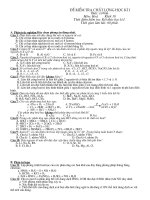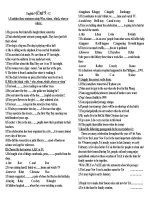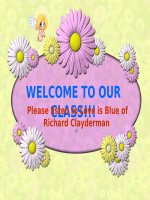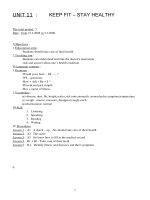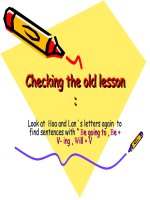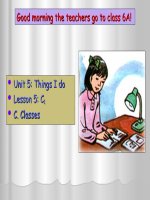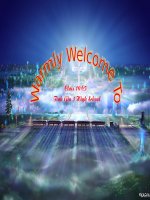Unit 10-Anh K10 CB-GH
Bạn đang xem bản rút gọn của tài liệu. Xem và tải ngay bản đầy đủ của tài liệu tại đây (245.91 KB, 16 trang )
Tu Ky High School – Lesson Plan – Grade 10
TiÕt thø: 60
Ngµy so¹n: 20/01/2008
Unit 10 conservation
A. Reading
I. Objectives
By the end of the lesson, Ss will be able to:
- use vocabulary items related to the issue of conservation
- guess the meaning of words based on contexts and components of the words
- scan for specific information about conservation - skim for general ideas about
conservation
II. Materials
Textbook, handout
III. Anticipated problems
Ss may not know much about conservation, so T should be ready to give explanation.
IV: procedure
Steps
Work
arrangement
Time
WARM-UP
Guessing game
- T prepares a piece of paper with the word "conservation".
- T asks one student to go to the board and gives him/her the paper.
- T asks other students to ask the student yes/no questions to guess what
the word is. T can model some questions. The questions can be: I
+ Is the word a verb?
+ Is it a noun?
+ Does it begin with "c"? I
- Ss take turns to ask questions. The winner is the one who can guess the
word correctly in the shortest period of time.
Whole class
5’
BEFORE YOU READ
Discussing the questions based on the pictures
- T uses the pictures on page 104 to introduce, the topic of the lesson to
Ss.
- Then T asks Ss to work in groups of 5 to discuss the questions in the
textbook
- T goes a round to provide help
- T asks some Ss to present their group's answers and others to add any
other ideas.
Pre-teaching vocabulary
Note: T should only teach the words which do not appear in Task l.
- T elicits or teaches some vocabulary items:
1. Destroy (v): end sth, kill sb/ sth (phá hủy, hủy hoại)
2. Destruction (n): the act of destroying
3. Constant (adj): always present or available (kiên định)
4. Play an important part in sth: đóng vai trò quan trọng
5. Conserve (v): protect sth from harm (giữ gìn, bảo tồn)
6. Clean up (v): make sth clean or neat (làm sạch, dọn dẹp)
Group work
& Whole
class
8’
NguyÔn Thanh TuÊn
Trang 135
Tu Ky High School – Lesson Plan – Grade 10
7. Worsen (v): to become worse, to make sth become worse (trở nên tồi tệ
hơn)
8. Pass laws: thông qua luật
T may want to ask some Ss to make sentences with the above words to
check their understanding.
WHILE YOU READ
Setting the scene
You are going to read a passage about conservation. While you are
reading, do the tasks in the textbook.
Task 1: Matching based on word guessing
Instruction: You are required to match the word in column A with a
suitable definition in column B.
- T writes the words on the board:
Eliminate, circulation, run-off, hydroelectric
- Then T instructs Ss to read the passage quickly and stop at the lines that
contain these words to guess their meanings.
- Ss guess the meaning of the words based on the contexts in the
sentences and the components of the words. For example, to guess the
meaning of eliminate Ss read the sentence 2 in paragraph A. Then based
on this sentence and other words in the first sentence (loss, destroying) Ss
can guess the meaning of this word. Also, T can help Ss analyze the
formation of the word: hydroelectric= hydro (water, liquid) + electric.
- T checks that Ss understand the words correctly. T can check Ss'
understanding by asking them to provide the Vietnamese equivalents to
the words.
- Then T instructs Ss to use some strategies to do task l:
+ First, Ss should read through the definitions provided in column B to
understand these definitions. Then, Ss match each word with the suitable
definition.
- T asks Ss to work individually to do the matching
- T goes around to help Ss when necessary.
- T asks Ss to exchange their answers with other Ss.
- T asks Ss for their answers and asks other students if they agree with
their friends' answers
answers:
l. c 2. a 3.d 4. b
Task 2: True or False
Instruction: You are to read the passage and decide whether the
statements are True (T) or False (F)
- T instructs Ss to use some strategies to do the task:
+ First, quickly read through the statements to get an idea about the topic.
+ Read the first statement more carefully. Underline the key words to
understand the main point.
+ Search for the section of the text which deals with the idea or fact.
+ Once finding the relevant section, read it carefully. If the statement is
similar to the information in the text, then select "True". If the statement
is the opposite to the information in the text, then select "False".
+ Continue with the rest of the statements.
Whole class,
Individual
work & Pair
work
7’
7’
NguyÔn Thanh TuÊn
Trang 136
Tu Ky High School – Lesson Plan – Grade 10
- T asks Ss to work individually to do the task.
- T asks Ss to discuss their answers with their peers.
- T calls on some Ss to give their answers and asks them to explain their
choices.
answers:
1. T (line 2)
2. T (lines 3-5)
3. T (lines 11-12)
4. T (lines 15-16)
5. F (Without plants, most water would run off as soon, as it falls. Rapid
run-off would cause floods –lines 11-12)
6. F (We can stop worsening the problems -lines 20-21)
Task 3: Choosing the main idea for each paragraph
Instruction: You are to read the passage again choose the most suitable
main idea for each paragraph
- T instructs Ss to use some strategies to do the task:
+ Read the first paragraph carefully and try to sum up, in the Ss' own
words, what it is about.
+ Then search through the list of main ideas provided in the task to find
the most suitable answer.
+ Make sure the main idea chosen sums up the entire paragraph and not
just one idea within it.
+ Continue with the rest of the paragraphs.
- T asks Ss to work in pairs to do the task.
- T goes around to offer help when necessary.
- T asks Ss to exchange their answers with other pairs.
- T calls on some Ss to give their answers and asks other Ss to say
whether they agree or disagree.
- T gives feedback and the correct answers:
A. 3 B. 4 C. 2
AFTER YOU READ
Instruction: You are required to work in groups to discuss the questions
in the textbook.
- T divides Ss into 6 groups: 1,2,3,4, 5 and 6
- T asks group 1 and 2 to discuss question 1, group 3 and 4 question 2,
and group 5 and 6 question 3.
- T goes around to help the groups when necessary. When all groups have
finished, T asks every two groups to share ideas with each other.
- T calls on some groups to report their ideas to the class.
- T gives feedback.
Group work
& Whole
class
10’
WRAPPING UP
- T summarises the main points.
- T asks Ss to learn by heart all of the new words and do the extra exercise
as homework.
Whole class 3’
Extra exercise:
Read the passage and answer the questions.
SAVE THE FOREST
NguyÔn Thanh TuÊn
Trang 137
Tu Ky High School – Lesson Plan – Grade 10
A change is coming in the forest. Scientists are trying to make the logging companies stop clear cutting.
We have to protect the fish, wildlife, and water quality. They have value, too. The forest is a beautiful
place that people should be able to enjoy.
It changes everything when all the trees are cut. The trees, animals, and water depend on each other.
Many plants and animals disappear. The water level in the ground changes. It can even affect our
climate.
This does not mean some of the trees cannot be cut. It just means all the trees in one place cannot be cut
at one time. It means that you plant new trees when the old ones are cut. When trees are cut in this way,
the land does not erode. The streams do not fill with dirt and the animals are not destroyed. The industry
is beginning to cut trees this way. They are leaving many dead trees, so small animals will have homes.
They are leaving many trees alone to give shade and shelter for animals. This also means that the forest's
trees are not all the same kind. This seems very important to the survival of the forests.
Both the loggers and the forest scientists are trying to agree on things. They have to balance the lumber
we need with the forest's protection. A good rule seems to be not to cut more than you grow each year.
1. What is a change corning in the forest?
2. What will happen if people plant new trees when they cut the old ones?
3. Why are they leaving many trees alone?
4. What are the loggers and the forest scientists trying to agree on?
Answers:
1. Scientists are trying to make the logging companies stop clear cutting.
2. If people plant new trees when they cut the old ones, the land does not erode, the streams do not fill
with dirt, and the animals are not destroyed.
3. To give shade and shelter for animals.
4. They have to balance the lumber we need with the forest's protection and not to cut more than we
grow each year.
Rót kinh nghiÖm giê d¹y:
...........................................................................................................................................................................
...........................................................................................................................................................................
TiÕt thø: 61
Ngµy so¹n: 22/01/2008
Unit 10 conservation
B. Speaking
I. Objectives
By the end of the lesson, the Ss will be able to:
- ask for someone's opinions, and show their agreement or disagreement about the new kind of
zoo
- talk about the advantages and disadvantages of the new kind of zoo
- report on discussion results
II. Materials
Textbook, pictures
III. Anticipated problems
Ss may not know some words in this section, so T should be ready to explain them.
IV: procedure
Steps
Work
arrangement
Time
WARM-UP
Picture describing
NguyÔn Thanh TuÊn
Trang 138
Tu Ky High School – Lesson Plan – Grade 10
- T prepares two pictures of zoos. The first one shows a traditional zoo
where animals are kept in cages. The second one shows a new kind of zoo
where wild animals can live in their natural habitat. T can print these
photos and distribute to Ss.
- T asks Ss to work in pairs to describe the pictures. One student will keep
the first picture, and the other keep the second. They should not let the
other student see their picture. Then they begin to ask and answer
questions about each other's picture. Finally, Ss can show their peer their
picture. They can base their discussions on the following questions:
+ What can you see in the first picture?
+ Is the animal in the first picture free to run?
+ How might the animal feel?
+ What can you see in the second picture?
+ Are the animals in picture two free to run?
+ How might the animals feel?
- T asks some pairs to present their answers.
- T gives feedback on Ss' answers.
- T introduces the new lesson: You are going to discuss the new kind of
zoo.
Pair work 7’
Task 1: Discussing the questions about the features of the new kind
of zoo
Instruction: You are required to work in pairs to put the actions in the
order of importance and then say what we should or should not do.
- T asks Ss to read through the two paragraphs.
- T elicits or teaches some new words:
1. Sensitive (adj): quick to respond to, or be affected by slight changes,
signals, or influences (nhậy cảm)
2. Imprison (v): put or keep in prison (bỏ tù, giam cầm)
3. Reconstruct (v): build again (xây dựng lại)
4. Breed (v): cause (an animal) to produce offspring (gây giống, nhân ~)
5. Reintroduce (v): put (a species of animal or plant) back into a former
habitat (trả về môi trường sống tự nhiên)
T asks Ss to work in pairs to discuss the two questions in the book using
the information in paragraph A and B.
- T goes around to observe Ss working.
- T asks some Ss to present their answers.
- T gives feedback and correct answers:
1. They are opened to help endangered species develop.
2. The animals are not kept in cages. They can live in their natural
environment.
Task 2: Showing agreement or disagreement about the new kind of
zoo
Instruction: Following are some ideas about the new kind of zoo
discussed in task 1. You are required to show your agreement or
disagreement by ticking the right box. Then share your ideas with a
partner.
- Before Ss do the task, T elicits or introduces some structures Ss can use
to ask for someone's opinions, to give their opinions, and show their
Pair work
Individual
work & Pair
work
7’
8’
NguyÔn Thanh TuÊn
Trang 139
Tu Ky High School – Lesson Plan – Grade 10
agreement or disagreement politely:
Asking for opinions Giving opinions
What do you think of ...?
Do you think ...?
Do you agree with ...?
I think.. . .
I don't think.. .
In my opinion.
Showing agreement Showing disagreement
I agree with. . .
Yes, I think you are right.
Exactly.
I don't really think so.
Yes, . . . but. . .
I would doubt that...
- T asks Ss to work individually to tick the suitable box to show their
agreement or disagreement.
- T asks Ss to work in pairs to share their ideas. Ss can explain their
ideas as well.
- T goes round to observe and offer help, taking notes of Ss' mistakes for
later correction.
- T calls on some Ss to talk about their ideas and asks other Ss to add
more.
- T gives feedback.
Task 3: Discussing the advantages and disadvantages of the new
kind of zoos.
Instruction: You are going to discuss the advantages and disadvantages
of the new kind of zoo using the cues provided in the textbook.
- T asks Ss to work in groups to discuss the advantages and disadvantages
of the new kind of zoo.
- T assigns a group leader for each group to make sure that group
members work cooperatively and take notes of other members' points.
- T goes round to observe and offers help.
- T takes notes of Ss' mistakes for later correction.
Task 4: Reporting on the discussion results
- T calls some Ss to 'report. that their groups have discussed. T asks other
Ss to takes note and compare with their groups' ideas.
Group work
Whole class
8’
8’
FEEDBACK AND CORRECTION
- While Ss report, T takes notes of their errors. Then T gives feedback
on Ss' answers.
- T corrects any typical mistakes.
Whole class 7’
WRAPPING UP
- T summarises the main points.
- T asks Ss to do the extra activity as homework.
Whole class 2’
Extra activity:
Last week you visited a zoo of the new kind. Now write a letter to one of your friends to tell him /
her about the zoo. Remember to describe the zoo and express your opinions about the
advantages and disadvantages of the zoo.
Rót kinh nghiÖm giê d¹y:
...........................................................................................................................................................................
...........................................................................................................................................................................
TiÕt thø: 62
NguyÔn Thanh TuÊn
Trang 140
